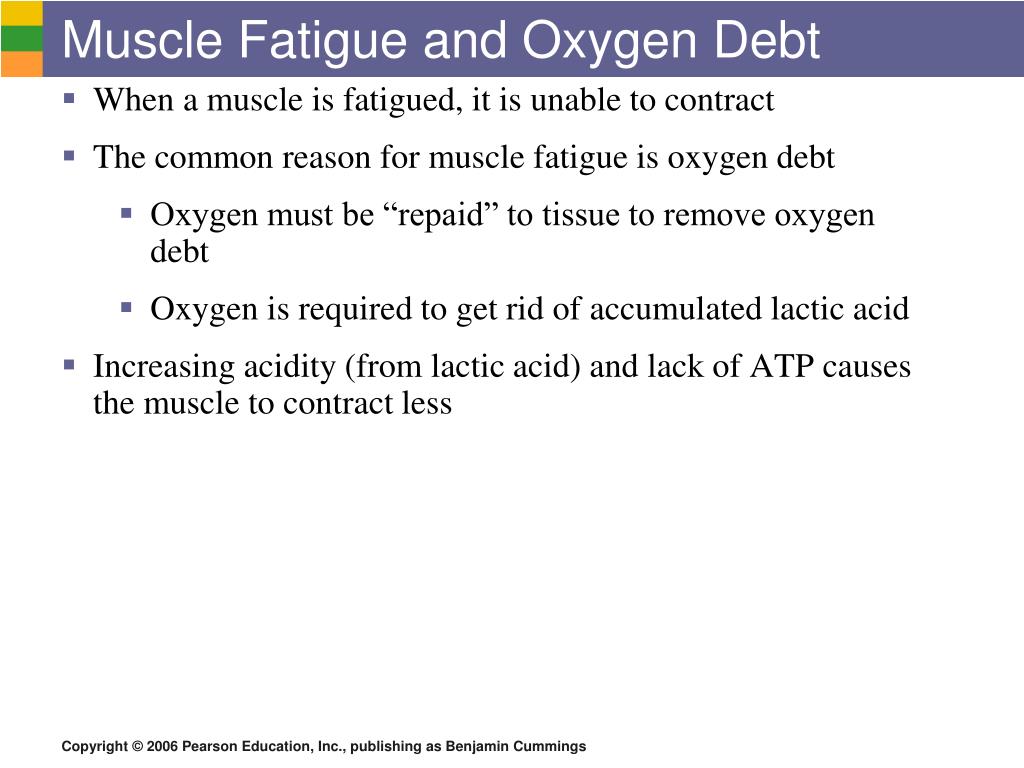
Muscle fatigue is the main factor that inhibits muscle contraction. Muscles need oxygen and energy to contract and muscle fatigue is the lack of oxygen in a muscle.
This shortage of oxygen is called Oxygen Debt.
Muscle fatigue and oxygen debt. Instead inorganic phosphate which increases during fatigue due to breakdown of creatine phosphate appears to be a major cause of muscle fatigue. One may also ask what causes oxygen debt in muscles. Oxygen debt is a term used to describe exertion which causes an increase in lactic acid production.
Despite the conventional wisdom lactic acid is not actually responsible for muscle fatigue. But it does play a big role in oxygen debt in muscles. MUSCLE FATIGUE AND OXYGEN DEBT by LAWAL.
MUSCLE FATIGUE AND OXYGEN DEBT written by LAWAL was published in the year 2018. It has details on energy metabolisms Oxygen Debt muscle fatigue. This book was uploaded for 200 level Medical Pharmaceutical and Health science students of University of Ilorin.
It is recommended for BCH223 course. Despite the conventional wisdom lactic acid is not actually responsible for muscle fatigue. But it does play a big role in oxygen debt in muscles.
Excess post-exercise oxygen consumption is the wordy sports science way of saying Why you tend to hyperventilate for a. To explain muscle contractions and how muscle works. Zoom presentation tips to bring human connection into virtual meetings.
Oxygen debt occurs when the muscles are working faster than energy can be produced aerobically. Muscles are fatigued at this point. Energy is still produced but it.
A cause of muscle fatigue If prolonged activity depletes oxygen supply glycolysis ensues and lactic acid will build up. This messes with muscle cell metabolic activity Causes muscles to feel tired and burning after vigorous exercise. To summarize these definitions oxygen debt is the amount of extra oxygen required by muscle tissue during recovery from vigorous exercise.
The debt can be measured as the difference between the amount of oxygen required after strong muscular activity and the amount required in a resting state. Why Oxygen Plus Enhances Oxygen Deficit and Oxygen Debt. Breathing hypoxic air can significantly increase muscle fatigue in vivo 30 31 and enhanced O 2 delivery to the exercising muscles 32 directly attenuates.
Muscle use can quickly overwhelm the ability of the body to deliver oxygen. Muscle fibers must switch to anaerobic metabolism and produce lactic acid at which point the muscle begins to fatigue. The difference between the amount of oxygen needed by the muscles and the actual amount present is called the oxygen debt.
The chart above is often seen and shows how the amount of oxygen used by the body changes over time. In the beginning the body works anaerobically leaving an oxygen deficit. Over time the oxygen consumption levels out to a steady-state.
After exercise the oxygen is paid back oxygen debt. Muscle fatigue is the main factor that inhibits muscle contraction. Muscles need oxygen and energy to contract and muscle fatigue is the lack of oxygen in a muscle.
It is well established that altering O2 delivery to contracting skeletal muscle affects human performance. In this respect a reduced O2 supply eg hypoxia increases the rate of muscle fatigue whereas increasing O2 supply eg hyperoxia reduces the rate of fatigue. What happens in muscle tissue as oxygen debt occurs.
If anaerobic activity takes place over a long period of time. The accumulation of lactic acid in muscles contributes to muscle fatigue and muscle cramping. If you keep pushing yourself and building up your oxygen deficit your performance will deteriorate.
Conversely if your heart is really strong and powerful then its pumping lots of oxygenated blood your muscles are getting plenty of oxygen and aerobic respiration is continuing in your cells and not forming as much. Muscle fatigue is the main factor that inhibits muscle contraction. Muscles need oxygen and energy to contract and muscle fatigue is the lack of.
When the rate of muscle workactivity is greater than the amount of oxygen supplied by the body eventually leading to shortage of oxygen and results in fatigue. This shortage of oxygen is called Oxygen Debt. In other words if an anaerobic activity takes place over a long period of time then muscles soon becomes exhausted because.
Reserves in the muscles become low as more glucose is used for respiration and additional glucose is transported from the liver. This build-up of lactic acid produces an oxygen debt. An Oxygen Debt is The amount of extra oxygen needed by muscle tissue to oxidise lactic acid following exercise.
During vigorous exercise the body needs a lot more energy and therefore has to get more oxygen into the muscle tissue where energy is. Lactic acid is formed and accumulated in the muscle under conditions of high energy demand rapid fluctuations of the energy requirement and insufficient supply of O2. During intense exercise sustained to fatigue muscle pH decreases to about 64-66.
Force generation does not appear to be limited by. What is the relationship between oxygen debt and muscle fatigue and an elevated respiratory rate after exercise. 1 See answer NatalisaRock.
Locomotion and Movement - Muscle Fatigue Oxygen Debt Rigor Mortis - YouTube. Locomotion and Movement - Muscle Fatigue Oxygen Debt Rigor Mortis. Temperature skeletal muscle mitochondrial functions and oxygen debt.
Temperature skeletal muscle mitochondrial functions and oxygen debt Am J Physiol. Fatigue Female Male Mitochondria Muscle enzymology. WorkplaceTesting Explains Oxygen Debt.
Oxygen is used by the cells to produce energy using a process called aerobic respiration. During strenuous exercise the body cannot deliver enough oxygen to the muscle cells. This status is referred to as an oxygen deficit.
Once the body reaches a state of oxygen deficit during exercise energy is.
